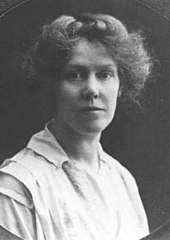Edith Maryon
Edith Louisa Maryon (born February 9, 1872 in London , † May 2, 1924 in Dornach / Switzerland ) was an English sculptor . Along with Marie von Sivers and Ita Wegman , she belonged to the innermost circle around the founder of anthroposophy, Rudolf Steiner .
life and work
Edith Maryon grew up as the second of six children of the wealthy master tailor John Simeon Maryon and his wife Louisa Church in central London. She attended a girls' school and later a boarding school in Geneva, Switzerland . In the 1890s she studied sculpture at the Central School of Design in London , from 1896 at the Royal College of Arts , which she appointed in 1904 as an "Associate". She went public with fully sculpted portraits and created reliefs in a classically inspired, traditionalist style.
In 1909 she was accepted into a successor organization to the Hermetic Order of the Golden Dawn , the Stella Matutina order led by Robert Felkin . Through his mediation, she was introduced to Rudolf Steiner . First personal encounters with Steiner followed in Berlin and The Hague .
In 1913 she temporarily moved to Germany, first to Munich , then to Berlin. From the summer of 1914 on she lived and worked entirely in Dornach, where she helped build the first Goetheanum . With Steiner she was largely responsible for the design of the well-known large-scale sculpture The Representative of Humanity between Lucifer and Ahriman as well as colored eurythmy figure sculptures, which she also made in wood. These works are stylistically close to Expressionism . While many sides demanded that the Representative of Humanity be set up soon , Maryon opposed any haste. For this reason, the work was not destroyed in the fire of the first Goetheanum on New Year's Eve 1922/23 and is still exhibited in the second Goetheanum today.
When there was a housing shortage in Switzerland, Maryon - together with Paul Johann Bay - designed three houses for employees on Dornacher Hügel from 1920 to 1922. At that time called “English houses”, today they are called eurythmy houses .
Maryon was in personal and letter contact with her teacher Steiner, especially in the last years of her life. In a brotherly and sisterly way, he confided a great deal to her and dedicated some of his texts to her. While working in the sculptor's studio around 1916, she once saved him from a serious fall. In 1923 Maryon fell seriously ill. At the end of the year she was appointed head of the Section for Fine Arts at the Goetheanum , without being able to hold the office, and died the following year of complications from tuberculosis .
The Edith Maryon Foundation was established in 1990 to commemorate their commitment to social housing.
literature
- Christian Bärtschi: Maryon, Edith. In: Historical Lexicon of Switzerland .
- Rex Raab : Edith Maryon. Sculptor and colleague of Rudolf Steiner; a biography [...]. Dornach: Philosophisch-Anthroposophischer Verl. Am Goetheanum, 1993. ISBN 3-7235-0648-8
- Rembert Biemond: Edith Maryon. In: Anthroposophy in the 20th century: e. Cultural impulse in biographical portraits. Edited by Bodo von Plato. Dornach: Verl. Am Goetheanum, 2003. ISBN 3-7235-1199-6
- Peter Selg : Edith Maryon. Rudolf Steiner and the Dornach Christ sculpture . Verlag am Goetheanum, Dornach 2006.
Web links
- Literature by and about Edith Maryon in the catalog of the German National Library
- biography
Individual evidence
- ↑ She was accepted into the order on September 4th, 1909 under the motto "Viam veram quero" ("I ask for the true path"). See: RAGilbert in The Golden Dawn Companion , 1986, p. 165.
- ↑ See also her correspondence with Steiner .
- ↑ Paull, John (2018) A Portrait of Edith Maryon: Artist and Anthroposophist , Journal of Fine Arts, 1 (2): 8-15.
| personal data | |
|---|---|
| SURNAME | Maryon, Edith |
| ALTERNATIVE NAMES | Maryon, Edith Louisa (full name) |
| BRIEF DESCRIPTION | English sculptress |
| DATE OF BIRTH | February 9, 1872 |
| PLACE OF BIRTH | London |
| DATE OF DEATH | May 2, 1924 |
| Place of death | Dornach |
